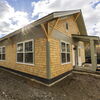Working downtown | A public-private partnership has been the key to remaking Main Street in Topsham
Now there is. Topsham's success in building an actual downtown ˆ it's known locally as the Lower Village ˆ has attracted widespread attention, though so far not widespread emulation by other Maine communities.
The success of the Lower Village project, which was conceived in the teeth of recession in 1992 and took almost 10 years to show tangible results, was the result of an unusual collaboration. Public and private economic development agencies, developers willing to work for the long term, and town officials willing to look far beyond the next election all worked together effectively.
By the 1990s, Topsham was growing fast, but it had little sense of identity, said Howard, who's president and CEO of Topsham development firm Priority Group. His firm owns the Border Trust building and the nearby Moncure & Barnicle law building. According to the latest U.S. Census estimates, Topsham has now pulled ahead of Bath as Sagadahoc County's largest municipality, with 9,564 residents; Bath has 9,382.
The 1992 redevelopment plan charted a new direction to establish a downtown identity. It was clear that the Topsham Fair Mall, just off Interstate 295, would be the major retailing center, but that left room for a more service-oriented district in the Lower Village. And that, step by step, is what Topsham created.
The results speak for themselves. The Lower Village district employs 350 people, and offers a wide variety of services. There are restaurants, law offices, a spa and salon, banks, and a number of small shops. The value of some of the existing buildings has grown tenfold. Since the first renovated mill buildings opened in 1999, there have been additional structures added to the village almost every year since, with a bank building and law offices the most recent additions, in late 2006. The first key link was the 1998 revival of the mammoth Great Bowdoin Mill, which sits on a point overlooking the Androscoggin below the falls, offering an eye-catching, picture-postcard view to the thousands of drivers crossing the Androcoggin River bridge daily. Ten years ago, however, the mill was considered a huge white elephant. Several developers had failed in redevelopment attempts, and Down East magazine ran a 1997 cover story headlined, "Farewell to the Bowdoin Mill." That cover is framed on Howard's office wall, a reminder that sometimes the doubters are wrong.
A pedestrian feel
The developers who did come up with the winning formula for the Bowdoin Mill were Ric and Peter Quesada, who run the Fore River Co. in Portland. (For more on this, see "Mill rebound," page 30.) The Quesada brothers form a quiet but ever-present force in the lengthy records of Topsham Development Inc. TDI, as it is known, is a town agency, but combines aspects of a board of trade with the entrepreneurial outlook associated more with the private sector. Jim Howard served two three-year terms on TDI ˆ one in the 1990s, when the Lower Village plan was being written, and another more recently as it was coming to fruition.
Ric Quesada, Howard said, was the figure who was most successful in moving the Lower Village plan from concept to reality. "Ric is the reason we were able to complete the plan and bring it to life. Without the Bowdoin Mill restoration, we wouldn't have everything else you see here today," Howard said. "He's unusual for a developer ˆ very quiet and persistent. It took that kind of dedication to make things happen."
The Sea Dog Brewing Co. restaurant became the mill's marquee tenant, and the rest of the three-story building is now fully occupied. Along with the restaurant, which occupies nearly an entire floor, the mill includes medical and professional offices for firms including Midcoast Medical Group and Portland Surgical Associates. Three new buildings have been built on the site as well, and several decaying structures removed. In 2000, as work was beginning, the mill was valued at $364,000. By 2006, the property was valued at $4.8 million and, after a revaluation the following year, now carries a market value of $9 million.
Across Main Street in the rest of the Lower Village, which once hosted a gas station, town highway garage and decaying apartment buildings, the story is similar. The Border Trust property, on the site of the former gas station, was valued at $126,000 in 2002 and is worth $1.3 million today. The salon building, which also houses offices and two apartments, was has jumped in value from $62,000 in 2002 to $885,000 today.
In the remaking of the Lower Village, there is significant density and a pedestrian feel compared with the sprawl that attends most new office and retail expansion in Maine. But there's still on-site parking for each building. Rich Roedner, Topsham's town planner, said that the difference between what was there before is dramatic. "There was no defined separation between [Main Street] and what was next to it," he said. "Now there are sidewalks and curbing and landscaping ˆ all the things that help define village centers."
Traffic no longer speeds through on its way to Brunswick's much larger ˆ and also thriving ˆ downtown. "Narrowing the roadway and putting the buildings close to the street created the definition we were looking for," Roedner said.
Howard said that the lack of sound buildings in the Lower Village was actually a benefit for redevelopment. "In the 19th century downtowns, with their low rows of buildings and limited access, it's hard to sustain new development," he said. "There's just not enough parking. We got to design buildings for the era we live in, with the automobile, but also create a pedestrian environment." Parking lots, in the so-called "new urbanism" style, are behind the buildings they serve, the amenities in front.
Turmoil in Topsham
While the Lower Village was coming to life, a lot of other changes were coming to Topsham. The result was a period of turmoil, says Howard. "For 24 months, most of Main Street was torn up," he says. "There was a lot of construction, and a lot of disruption for people to deal with."
Among the changes was construction of an $11 million municipal government center on Upper Main Street near the intersection of Route 201 and Route 196, the Coastal Connector that links Interstate 295 and Route One. Once-scattered municipal buildings were relocated from a site on Route 24, north of the Lower Village, that now has facilitated expansion of The Highlands retirement community. The sale of the municipal buildings permitted the town to buy the Upper Main Street site and offset part of the construction cost.
Add to that major sewer reconstruction along Main Street and a big expansion of the Topsham Fair Mall, and it's understandable how growth might suddenly seem too much of a good thing.
"People who moved here from Massachusetts, seeking a quiet life, might have wondered what they'd gotten into," said Howard. "Now that things have settled down, we can see the results more clearly."
Rich Roedner said that Topsham, like most growing communities, was seeking a balance of retail, commercial, and residential development. Topsham also retains some industrial sites as well ˆ the highly visible Harry C. Crooker & Sons Inc. paving plant and two concrete plants are now in the middle of the Coastal Connector retail growth area.
Amidst the fights over the mall and, to a lesser extent, the new municipal offices, the Lower Village plan seems to attract less controversy.
"By and large, people seem to support it," said Rich Roedner. "Having our own village center has been a goal for a long time."
While it is not "a truly urban center, like Biddeford, Lewiston or Brunswick," the Lower Village "definitely has a sense of place. You know you're not just in one building or another," he said.
Roedner also suggested that the Lower Village may continue to change. "Downtowns aren't just built," he said. "They evolve over time."
Decades ago, downtown Brunswick might have looked more like Topsham's Lower Village does today, said Roedner. With rising energy prices and traffic-filled commutes, the creation of a new village center may look like a prescient move from the perspective of future generations, he said.
Paying dividends
The success of the 1992 comprehensive plan also has allowed the town to define three distinct sections along Main Street ˆ the Lower Village, with its service and office buildings; the Upper Village, a mix of retail, industrial, and municipal uses; and a historic residential community in between. Including changes for Upper Village zoning helped create unanimous support for a new comprehensive plan at a town meeting in January.
John Shattuck, who became Topsham's economic development director, and the executive director of TDI in February, provides a fresh perspective on Topsham's situation. (The TDI post had been vacant since the previous May.)
Shattuck served briefly in the Brunswick economic development department, and was eager to return to the midcoast, where a lot is happening, he said. Between substantial economic growth, its location as a transportation hub, and access to the ever-desirable Maine coast, Topsham and the midcoast is "in the middle of a whole range of new activities," Shattuck said.
He cites the work of Steve Levesque, former commissioner of the Department of Economic and Community Development during former Gov. Angus King's administration, as head of the redevelopment commission for the Brunswick Naval Air Station, due to close in 2011.
The BNAS closure represents "a tremendous opportunity" but it also has significant perils for the region, Shattuck said. While the communities haven't responded with the alarm Aroostook County experienced in 1994 when the closing of Loring Air Force Base was announced, the midcoast is not invulnerable, Shattuck said. "We have to look at replacing 4,000 good-paying jobs at the base," he said. "With the indirect employment impact, we could be looking at 7,000 jobs, which is a very substantial number for a region our size."
The effects of downsizing will start to be felt later this year, he said, and the major reduction in squadrons will be completed sometime in 2009.
Shattuck believes, however, that Topsham's decision to establish defined residential, service and retail areas of town will pay dividends in the future, allowing the community to attract employers who might otherwise have looked elsewhere.
For Jim Howard, there's great satisfaction in the view from his office window, and the dramatic "before and after" photos that chronicle the changes in Topsham. "This is something new, something that didn't exist before," he said. "That's something we can all be proud of."










Comments